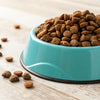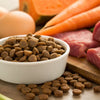Can Dogs Eat Raw Food and Kibble? Understanding the Benefits and Best Practices
- Houndsy
Table of Contents
- Introduction
- The Benefits of Mixing Raw Food and Kibble
- How to Safely Introduce Raw Food to a Kibble Diet
- Nutritional Considerations and Ratios
- Common Myths Surrounding Mixed Feeding
- Practical Tips for Pet Owners
- Conclusion
Introduction
As responsible pet owners, we often ponder the best dietary choices for our furry companions. Did you know that according to recent studies, nearly 80% of dog owners are considering or have already adopted a mixed feeding approach that combines raw food and kibble? This growing trend reflects a desire for balance, nutrition, and variety in our pets' diets. But amid the options, the question arises, can dogs eat raw food and kibble together?
In this blog post, we will delve into the intricacies of feeding dogs a mixed diet of raw food and kibble, exploring the benefits, potential challenges, and best practices. By the end, you will have a clearer understanding of how to navigate this feeding strategy and ensure your dog enjoys a nutritious and fulfilling diet.
We will cover several aspects of this topic, including:
- The benefits of mixed feeding
- How to safely introduce raw food to a kibble diet
- Nutritional considerations and ratios
- Common myths surrounding mixed feeding
- Practical tips for pet owners
So let’s embark on this journey to enhance our pets' feeding experience together!
The Benefits of Mixing Raw Food and Kibble
Feeding dogs a combination of raw food and kibble can offer numerous advantages, both in terms of nutrition and practicality. Here are some benefits to consider:
Nutritional Variety
One of the primary reasons many pet owners opt for mixed feeding is the nutritional diversity it provides. Raw food tends to be rich in proteins, moisture, and natural enzymes, while kibble offers convenience, shelf stability, and a balanced nutrient profile. By combining the two, we can deliver a well-rounded diet that incorporates the best of both worlds.
Improved Digestion
Many dog owners report improvements in their pets' digestion when incorporating raw food into their diets. Raw food can facilitate healthy gut flora, leading to better nutrient absorption and overall digestive health. When mixed with kibble, it may help alleviate common digestive issues associated with dry food alone.
Enhanced Meal Appeal
Picky eaters can be a challenge for any pet parent. Mixing raw food as a topper or base for kibble can make meals more enticing. The aroma and texture of raw food can stimulate our pets' appetites, encouraging them to eat their meals without fuss.
Cost-Effectiveness
While raw food can be more expensive, mixing it with kibble allows us to maintain budget-friendly feeding practices. Many pet owners find that they can stretch their raw food supply by blending it with high-quality kibble, making it a more sustainable option.
Convenience for Busy Lifestyles
Life can be hectic, and for many of us, preparing a fully raw meal every day may not be feasible. Incorporating kibble into our pets' diet provides a practical solution, allowing us to offer nutritious meals without the time-consuming preparation that raw feeding often requires.
How to Safely Introduce Raw Food to a Kibble Diet
Transitioning to a mixed feeding approach should always be done gradually to minimize digestive upset. Here are some steps to follow for a safe introduction:
Step 1: Assess Your Dog's Current Diet
Before making any changes, it’s essential to evaluate your dog’s current diet and health status. Consult with your veterinarian to determine the most suitable approach for your pet based on their individual needs, age, weight, and health conditions.
Step 2: Start Slowly
Begin by introducing raw food in small amounts alongside the regular kibble. A good starting point is to mix about 10% raw food with 90% kibble. Observe your dog for any signs of digestive upset, such as diarrhea or vomiting.
Step 3: Gradually Increase Raw Food
If your dog tolerates the initial mix well, gradually increase the proportion of raw food over a week or two. You might aim for a 50/50 mix as a common target, but this can vary depending on your dog's preferences and needs.
Step 4: Monitor and Adjust
Throughout the transition, keep an eye on your dog’s overall health and digestion. If any adverse reactions occur, consider adjusting the ratio or consulting your vet for further guidance.
Step 5: Maintain Consistency
Once your dog has successfully transitioned, maintain a consistent feeding schedule. Regular meal times can help establish a routine, making it easier for both you and your pet to adapt to the new diet.
Nutritional Considerations and Ratios
When mixing raw food and kibble, it’s crucial to strike the right balance to ensure that our pets receive adequate nutrition. Here are some key points to keep in mind:
Understanding Ratios
There isn’t a one-size-fits-all ratio of raw food to kibble; it largely depends on your dog’s lifestyle, activity level, and health. Here are some common ratios:
- 10% Raw / 90% Kibble: Good for initial transitions or for dogs with sensitive stomachs.
- 50% Raw / 50% Kibble: Often recommended for well-adjusted dogs that can tolerate both.
- 75% Raw / 25% Kibble: Ideal for those looking to maximize the benefits of raw feeding while still relying on kibble.
Choosing High-Quality Ingredients
Not all kibbles are created equal. When selecting kibble to mix with raw food, we should opt for high-quality brands that use whole food ingredients and avoid fillers, artificial additives, and unnecessary carbohydrates. This helps ensure that our dogs receive the nutrients they need without harmful ingredients.
Nutritional Gaps
While raw food is nutritious, it may not provide a complete diet on its own. High-quality kibble can help fill potential nutritional gaps, ensuring our pets receive a balanced intake of vitamins, minerals, and proteins.
Common Myths Surrounding Mixed Feeding
Despite the growing popularity of mixed feeding, several myths persist that can confuse pet owners. Let's debunk some of these misconceptions:
Myth 1: Mixing Raw and Kibble Will Cause Digestive Issues
Many believe that mixing raw food and kibble will lead to digestive upset. However, most dogs can adapt well to a mixed diet as long as the transition is gradual. Sudden changes in diet are more likely to cause issues than the combination itself.
Myth 2: Dogs Cannot Digest Different Food Types Together
It’s a common misconception that dogs’ digestive systems can't handle both raw and kibble at the same time. In reality, dogs have evolved to eat a variety of foods, and their digestive systems are equipped to process different macronutrients simultaneously.
Myth 3: Raw Food Is Always Better Than Kibble
While raw food offers numerous benefits, it may not be practical for all pet owners. Mixing raw food with kibble can provide a balanced diet that combines the advantages of both.
Practical Tips for Pet Owners
To make the most of a mixed feeding approach, we recommend these practical tips:
Opt for High-Quality Ingredients
Select high-quality kibble with natural ingredients and minimal fillers to complement the nutritional benefits of raw food.
Use Raw Food as a Topper
Rather than mixing raw food directly into kibble, consider using it as a topper. This can enhance flavor and texture while making mealtime more enticing for picky eaters.
Monitor Portion Sizes
Ensure you’re providing the appropriate portion sizes based on your dog's individual needs. Adjust the amount of kibble and raw food accordingly to prevent overfeeding or underfeeding.
Consult with Your Veterinarian
Whenever making significant changes to your dog’s diet, it’s essential to consult with a veterinarian. They can provide personalized advice and help you determine the best feeding strategy for your pet.
Gradual Introduction
Always introduce new foods gradually to minimize the risk of gastrointestinal upset. This allows your dog’s gut to adapt comfortably to the new diet.
Conclusion
In conclusion, mixing raw food and kibble can be a beneficial feeding strategy for many dogs, allowing us to provide a nutritious, varied, and practical diet. By understanding the benefits, carefully transitioning, and monitoring our pets, we can create a feeding routine that enhances their health and happiness.
As pet owners, we have the unique opportunity to nurture our furry friends through thoughtful choices in their diets. If you’re exploring ways to elevate your dog's feeding experience, consider the Houndsy Kibble Dispenser. Our innovative design simplifies portion control and enhances the overall feeding ritual, making mealtime a breeze. Order Now to experience the convenience and style of the Houndsy Kibble Dispenser for yourself!
FAQ
Can I mix raw food and kibble for my dog?
Yes, most dogs can safely consume a mixture of raw food and kibble. It's important to introduce the two gradually and monitor your dog's response.
How much raw food should I mix with kibble?
The proportion can vary based on your dog’s needs, but a common starting point is a 10% raw to 90% kibble ratio, gradually increasing as tolerated.
Will mixing raw food and kibble cause digestive problems?
Not necessarily. Digestive issues are more likely to occur due to sudden dietary changes rather than the combination itself.
What should I look for in kibble when mixing with raw food?
Choose high-quality kibble made from natural ingredients, with minimal fillers and a good balance of protein, fat, and carbohydrates.
Can I use raw food as a topper for kibble?
Absolutely! Using raw food as a topper can enhance the flavor and appeal of your dog's meals while providing nutritional benefits.













